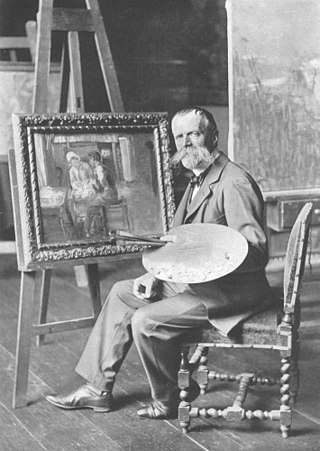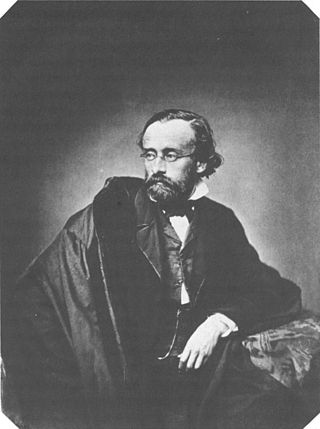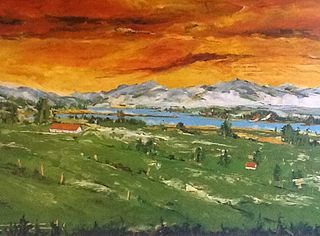Friedrich Ludwig (1895–1970) was a German expressionist painter. He created art using oil paint, chalk, gouache, and watercolor paints.

Willi Baumeister was a German painter, scenic designer, art professor, and typographer. His work was part of the art competitions at the 1928 Summer Olympics and the 1932 Summer Olympics.

Fritz von Uhde was a German painter of genre and religious subjects. His style lay in-between Realism and Impressionism, he was once known as "Germany's outstanding impressionist" and he became one of the first painters to introduce plein-air painting in his country.
Hermann Traugott Rüdisühli was a Swiss painter, a member of the Rüdisühli family of artists. He created more than 1,000 paintings, primarily landscapes, portraits and allegories.

Karl Oenike (1862–1924) was a German landscape painter, who participated in various scientific expeditions in South America during the years 1887-1891 as painter and photographer. He wrote detailed diaries, made topographical maps, drawings, sketches, watercolors, oil paintings and photos during these expeditions, which give a valuable perspective of remote regions and populations, and of the difficulties encountered by German explorers in the 1880s. Few artists in the exotic art genre have depicted better the “magic of the forest” in his paintings.
Rupprecht Geiger was a German abstract painter and sculptor. Throughout his career, he favored monochromicity and color-field paintings. For a time, he concentrated solely on the color red.

Munich School is the name given to a group of painters who worked in Munich or were trained at the Royal Academy of Fine Arts of Munich between 1850 and 1918. In the second half of the 19th century the Academy became one of the most important institutions in Europe for training artists and attracted students from across Europe and the United States.

Christian Adam Landenberger was a German Impressionist painter and a professor at the State Academy of Fine Arts Stuttgart. He is especially known for his landscapes.

Eduard Schleich was a German painter. He is generally referred to as The Elder to distinguish him from his son Eduard, who was also a painter.

Hans-Jörg Holubitschka was a German painter. He studied at the Kunstakademie Düsseldorf. Holubitschka lived and worked in Düsseldorf. At the Ruhrakademie in Schwerte he taught the subject painting.

Armin Baumgarten is a German painter and sculptor.
Norbert Prangenberg was an abstract painter, sculptor, and engraver who was born in Nettseheim, just outside of Cologne, Germany. Though he had no formal training and did not fully engage with art until his 30s, Prangenberg did finally come up with a style that was uniquely his own, not fitting comfortably into the neo-expressionist or neo-geo movements of his time, in the 1970s and 1980s. At this time, he was considered a major figure in contemporary German art. Though he got his start with abstract paintings, he also became known for making sculptures of all sizes; and while his work initially appears abstract, the titles given sometimes allude to the human body or a landscape. As a trained gold- and silversmith, as well as a glassblower, he always showed an attention to materials and how they could be physically engaged with. He was interested in how his own two hands could affect the painting or sculpture's surface. Traces of the artist's hand appear literally throughout his entire oeuvre, before he lost the battle with liver cancer in 2012.
Emmy Lischke (1860-1919) was a German painter known for her landscapes and still lifes.

Hermann Freiherr von Königsbrunn was an Austrian landscape painter.

Friedrich Schaarschmidt was a German landscape painter and figure painter of the Düsseldorf school of painting, conservator and art writer.
Fred Kocks in Düsseldorf was a German landscape and figure painter, draughtsman and lithographer as well as curator, museum director and author.

Eduard Kaempffer was a German painter, sculptor and medallist.
Roman Norbert Ketterer was a German auctioneer, gallery owner and art dealer.

Max Eduard Giese was a German landscape and cityscape painter, associated with the Düsseldorfer Malerschule.

Johann Heinrich Höfer was a German landscape and portrait painter.












